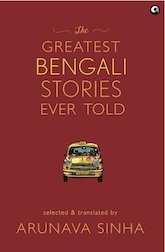The Greatest Bengali Stories Ever Told
Selected & Translated by Arunava Sinha

Hardcover: 305 pages
|
Aleph’s new book comes with a beautiful cover and a courageous title. The Greatest Bengali Stories Ever Told, selected and translated by Arunava Sinha, is definitive in its name, and no doubt, its claim will invite, in equal parts, both curiosity and debate. But then, there’s that introduction by Sinha inside, titled ‘My Love Affair with Bengali Stories’, where the book’s name finds true meaning, and where Sinha shares some of his own stories; memories inseparably linked in his mind to each story in the book. You discover that this book isn’t a “potted history of the Bengali short story” as Sinha puts it, but really, a personal list of favourites; a love letter of sorts from Sinha to the language, land and literary form that gave him his “life as a translator”. While this is not a definitive selection, is it certainly a worthy one, and even though he hasn’t done so intentionally, Sinha has given us, in 21 stories, a range of styles, voices and setting across the very rich, very fertile ground of Bengali literature. Within these pages, the short story thrives, and you see what the form can do in the hands of masters. There is Rabindranath Tagore’s very gentle, very human touch in ‘Kabuliwalla’; Banaphool’s ‘Homecoming’, shot through with an undercurrent of playful laughter, its end so perfectly timed and crafted; Sunil Gangopadhyay’s ‘Post-mortem’, a provocative, expertly woven dialogue-story and Moti Nandy’s sharply perceptive, psychological exploration that is ‘News of a Murder’. At one point in the introduction, Sinha explains how he needs a short story to place him “right in the middle of the action” before he can make it his own. He claims that no novel can really do this, taking into account just the number of “distractions” (“too much reflection, thought, shift of perspective”). At first, I understood these words in a theoretical, removed sort of way. And then, I read the story that had prompted this reflection in the first place — ‘Mahesh’ by Sarat Chandra Chattopadhyay. When Sinha first came across it, he had been a 10-year-old boy, listening to his mother read the story aloud in an attempt to distract her hungry son. I read it now, years later, and suddenly find myself truly appreciating Sinha’s meaning, and experience. Almost without realising it, I’m there in the story, next to the starving bull Mahesh and his impoverished, miserable master Gafoor. Everything is in sharp clarity, and the story moves with the heady speed that Sinha describes accurately as a “breathless ride”. It seems to last both a lifetime and a moment, its world contained within the capsule of the few pages. Yes, perhaps Sinha is right, perhaps no novel could give you this vivid, intense, absolute moment, both fleeting and infinite. Again and again, each story in the collection creates these moments, and each does it in its own distinct way. A word on the translations themselves, and the way in which Sinha retains the very essence of the stories, the style of the author, and the pull of the language. You can recognise the original voices in the translations, and for those who cannot access these stories in Bengali, here is the next best option. Interestingly, while the result of one individual’s 40-odd years-long relationship with Bengali literature, the book remains entirely the readers’. By drawing a connection between his personal experiences and the stories in the book, Sinha succeeds in allowing every reader to do the same — either by creating new memories, or recalling old ones. So, as I read about Sinha skipping his university convocation to knock on Satyajit Ray’s door, I find myself remembering how warm th weather had been on the day I dragged a chair, too heavy for my spindly 12-year-old arms, out in the garden to read my first Ray story, this time in Hindi, and titled, quite deliciously, ‘Mister Brown’s Cottage’. Swati Daftuar| 1 May 2016 | The Hindu
|
